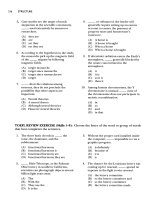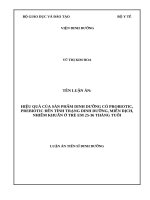25 pre
Bạn đang xem bản rút gọn của tài liệu. Xem và tải ngay bản đầy đủ của tài liệu tại đây (99.38 KB, 6 trang )
Experiment 25 Prelaboratory Assignment
Calorimetry
1. A 20.94g sample of a metal is heated to 99.4 oC in a hot water bath until thermal
equilibrium is reached. The metal sample is quickly transferred to 100.0 mL of water
at 22.0oC contained in a calorimeter. The thermal equilibrium temperature of the metal
sample plus water mixture is 24.6 oC. What is the speci c heat of the metal? Express the
speci cheat with the correct number of signi can’t gures.
Mass of the metal is 20.94 g
Temperature of the metal is 99.4 oC
Volume of water is 100 mL
× ΔTT
Temperature of water is 22 oC
Equilibrium temperature is 24.6 oC
Initially, we calculate the heat lost by the metal as
Heat lost = mc ΔTT
= 20.94g × c × (99.4 oC - 24.6 oC)
= 1566.312 c J
Calculating the mass of water as
Mass = Density × Volume
= 1 × 100 = 100 g
Now, we calculate the heat gained by the metal as;
Heat gained = mcΔTT
= 100g × 4.184 J/g°C × (24.6 °C -22.0°C)
= 1087.84 J
Thus, heat lost = heat gained
1566.312 c = 1087.84
=> c = 0.694 J/g°C
Therefore, the specific heat of the metal is 0.694 J/g°C
2. a. Experimental Procedure, Part A.1. What is the procedure for heating a metal to an
exact but measured temperature?
The 10-30g of metal is transferred to a test tube. Test tube is placed in boiling water
for 10 minutes or until it reaches equilibrium
b. Experimental Procedure, Part A.1. How can bumping be avoided when heating
water in a beaker?
When heating water in a beaker, avoid bumping:
1. Employ a boiling chip or stone.
2. While the water is heating, gently stir it.
3. To provide additional room, select a larger beaker.
4. Gradually heat the water.
5. Refrain from heating up excessively.
6. Position a wire gauze or heat-resistant mat between the beaker and the heat
source.
3. Experimental Procedure, Parts A.4, 5.
a. When a metal at a higher temperature is transferred to water at a lower
temperature, heat is inevitably lost to the calorimeter (Figure 25.4). Will this
unmeasured heat loss increase or decrease the calculated value of the specific cheat
of the metal? Explain. See equation 25.5
Since energy is the numerator, both the total specific heat and the heat loss are
reduced.
b. Explain why the extrapolated temperature is used to determine the maximum
temperature of the mixture rather than the highest recorded temperature in the
experiment. See Figure 25.5
- It uses the extrapolated temperature The extrapolated temperature is used to
adjust for the constant loss of heat in the system.
4. Experimental Procedure, Part B. Three student chemists measured 50.0 mL of
1.00 M NaOH in separate Styrofoam coffee cup calorimeters (Part B). Brett added
50.0 mL of 1.10 M HCl to his solution of NaOH; Dale added 45.5 mL of 1.10 M
HCl (equal moles) to his NaOH solution. Lyndsay added 50.0 mL of 1.00 M HCl
to her NaOH solution. Each student recorded the temperature change and
calculated the enthalpy of neutralization.
Identify the student who observes a temperature change that will be different from
that observed by the other two chemists. Explain why and how (higher or lower)
the temperature will be different.
Dale will be the one who notices a temperature difference from the other kids.
Dale has more NaOH solution and less HCl than the others. All of the
students had the same acid-based reaction, although Dale had a less overall
volume of solution. Because NAOH is the limiting reactant in the experiment,
his temperature will be higher than the others because he has a lesser volume
of solution..
5. Experimental Procedure, Part C. Angelina observes a temperature increase when
her salt dissolves in water.
a. The lattice energy for the salt is greater than the hydration energy for the salt.
The energy needed to separate the ions in a solid salt and turn them into
separated gaseous ions is referred to as lattice energy. As an endothermic
process, it needs energy to proceed. The energy released when water
molecules join with gaseous ions to create hydrated ions in solution is referred
to as hydration energy, on the other hand. Energy is released during the
exothermic process of hydration.
Since Angelina notices a rise in temperature when the salt dissolves in the
water in this instance, it is possible that the process of dissolution is absorbing
energy from the environment. This shows that the hydration energy, which
represents the energy released as the salt dissolves, is smaller than the lattice
energy, which represents the energy necessary to break the ionic lattice of the
salt. Because breaking the ionic lattice requires more energy, more energy
must be absorbed during the dissolving process, which raises the temperature.
b. The solubility of the salt will typically increase with temperature increases.
The majority of salts typically become more soluble as temperature rises.
This is due to the fact that rising temperatures give solvent molecules more
thermal energy, enabling them to travel faster and collide with solute particles
more frequently and energetically. The solute can dissolve more easily as a
result of these intense collisions, which can overcome the intermolecular
interactions holding it together.However, it is important to remember that not
all salts are affected by this interaction. With temperature changes, some salts
may have altered solubility behavior, such as lower solubility with higher
temperatures. Determining the impact of temperature on solubility requires
taking into account the individual solute and solvent involved.
6. A 5.00-g sample of KBr at 25.0oC dissolves in 25.0 mL of water also at 25.0 oC.
The nal equilibrium temperature of the resulting solution is 18.1oC. What is the
enthalpy of solution, ∆Hs, of KBr expressed in kilojoules per mole? See equation
25.12
Water has a mass of m (about 25.0 g in 25 mL).
Water has a 4.18 J/g°C specific heat capacity, or C.
ΔTT is the change in temperature (final temperature minus beginning
temperature)
q = (25.0 g) × (4.18 J/g·°C) × (18.1°C - 25.0°C)
q = -585.57 J (The negative sign denotes the discharge of heat)
The quantity of KBr must then be determined in terms of moles. The mass of
the sample can be converted to moles using the molar mass of KBr:
KBr's molar mass is 39.10 g/mol + 79.90 g/mol, which equals 119.0 g/mol.
n = mass / molar mass
n = 5.00 g / 119.0 g/mol
n = 0.0420 mol
In order to obtain the enthalpy of solution, we may now substitute the values
into the equation:
ΔTHs = q / n
ΔTHs = (-585.57 J) / (0.0420 mol)
ΔTHs ≈ -1.39 × 10^4 J/mol
Finally, by dividing by 1000, we can change the solution's enthalpy from
joules to kilojoules:
ΔTH ≈ -1.39 × 10^4 J/mol / 1000
ΔTH ≈ -13.9 kJ/mol
As a result, the enthalpy of solution (ΔTH) of KBr is approximately -13.9
kJ/mol.









